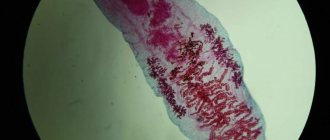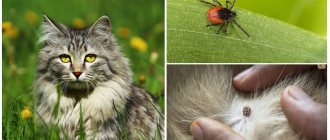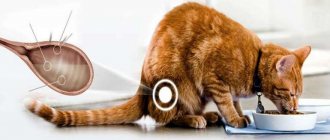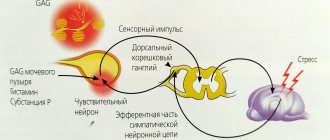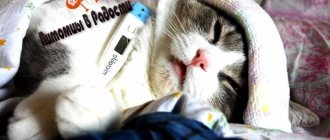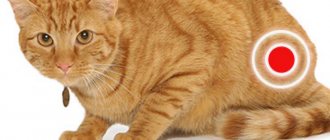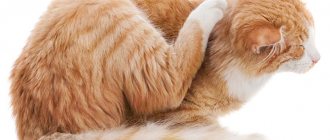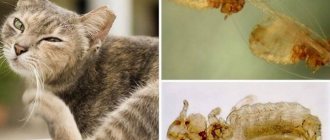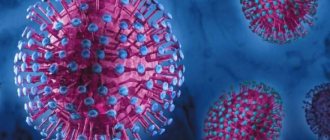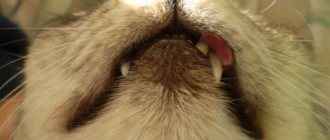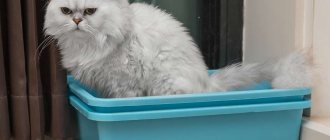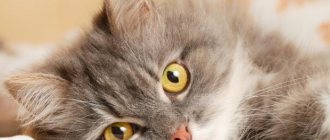Not only people can suffer from anemia; cats are also susceptible to this disease. It is characterized by a sharp decrease in the level of red blood cells and hemoglobin in the blood. Most often, veterinarians attribute anemia in cats not to an independent disease, but to a pathology caused by a more severe illness. Rarely does this condition have an isolated character. When anemia occurs, all tissues of the body do not receive enough oxygen, which, in turn, negatively affects the functioning of all organs and systems. The animal becomes lethargic, quickly tires and is reluctant to make contact. Sometimes there are disturbances from the gastrointestinal tract. You can’t ignore all the listed “bells”. If they appear, you should immediately contact your veterinarian. The specialist will determine the type of anemia and prescribe appropriate treatment.
Characteristics of the condition and its features
Anemia is characterized not only by a decrease in the number of red blood cells, but also by a drop in the level of hemoglobin, an iron-containing protein involved in gas exchange. Due to lack of oxygen and excess carbon dioxide, all internal organs suffer. This affects immunity, acid-base balance, heart and kidney function.
The disease in mustachioed pets is much more acute than in humans. The thing is that it takes too much time for the body to restore red blood cells. But in case of mass death it is simply not there, so saving the animal without veterinary care is impossible.
Hemoglobin norms in humans, cats and dogs
The amount of hemoglobin differs among representatives of different sexes:
- men - 130–160 g/l (minimum 120, maximum 180 g/l);
- women - 120-50 g/l;
- children: newborns - 145-225 g/l, from 3 months to six months - 95-135 g/l, from one year to 18 years - a gradual increase in indicators to the “adult” level.
During pregnancy, the hemoglobin concentration drops due to the increased load on the woman’s body, so it is important for a pregnant woman to monitor her blood counts.
In dogs, the hemoglobin norm is equal to the same norm in an adult man - 120-180 g/l, in puppies - 74-180 g/l.
In cats, the normal levels are lower - 80–150 g/l.
Types depending on the lack of a certain element
Symptoms and methods of treating anemia in cats depend on its type. The classification is based on the lack of a certain element.
Autoimmune (hemolytic)
Autoimmune, or hemolytic, anemia in cats develops when red blood cells are destroyed. Its main symptom is jaundice, caused by poisoning or disruption of hematopoietic processes.
Infectious
Infectious anemia in cats is caused by low hemoglobin concentrations caused by leukemia, immunodeficiency, salmonellosis, bartonellosis, or streptococcal infection. These diseases lead to malfunctions of the bone marrow.
Nutritional
This type of anemia often occurs in newborn kittens and animals younger than 1.5 years. Iron deficiency, associated with poor feeding or impaired absorption function, is to blame for its development.
Posthemorrhagic
Occurs due to internal and external bleeding, accompanied by loss of red blood cells and hemoglobin. Depending on the number and severity of wounds, it occurs in acute or chronic form. The main cause of this disease is flea infestations and helminthiasis.
Hypoplastic
Develops with a deficiency of vitamin B, iron, copper, cobalt and protein, as well as with toxin poisoning. Accompanied by a disorder of bone marrow functions.
Aplastic, or iron deficiency
Aplastic, or iron deficiency, anemia in cats is characterized not only by low levels of hemoglobin and red blood cells, but also by a reduction in the number of white blood cells. May be accompanied by an inflammatory process in the bone marrow or liver.
Description of the disease
The main function of red blood cells and hemoglobin is to transport oxygen molecules to all tissues of the body. When their content is reduced, cellular oxygen starvation of the body begins, metabolic processes and chemical reactions converting food elements into energy are disrupted.
In a healthy cat, the hemoglobin norm is 90-170 (g/l), erythrocytes - 5.2-10.8 (x 1012/l). A decrease in these indicators signals an insufficient supply of oxygen to the organs, as a result of which tissue respiration and redox reactions are disrupted, and damage to vital systems occurs: immune, lymphatic, hematopoietic, cardiovascular.
In veterinary medicine, based on clinical and laboratory characteristics, there are three main types of anemia with the following pathologies:
- posthemorrhagic - a consequence of chronic, acute blood loss;
- hemolytic (autoimmune, Heinz), caused by increased destruction of red blood cells;
- non-regenerative, associated with impaired formation of red blood cells - aplastic, hypoplastic, alimentary, iron deficiency, macrocytic, in chronic renal diseases.
Causes of anemia in cats
All causes of anemia can be divided into 3 large groups. These include:
- Destruction of red blood cells in the systemic circulation. This group includes poisoning with poisons, drugs and decay products of malignant neoplasms, as well as viral infections and autoimmune pathologies.
- Loss of blood due to bleeding. This includes injuries, gastrointestinal diseases (ulcers), piroplasmosis and helminth infection.
- Insufficiency of hematopoietic organs. In addition to bone marrow, these include the liver and spleen. Develops in cases of deficiencies due to unbalanced nutrition, in chronic diseases of the gastrointestinal tract and endocrine system that impair their functionality.
The risk group includes the Somali and Abyssinian breeds. They most often suffer from congenital instability and deformation of red blood cells.
Prevention
It is necessary to take precautions against worms and blood-sucking insects, and carry out regular preventive measures: seasonal use of anthelmintic drugs in a prophylactic dose, external means of protection against insects, regular checking of the fur for fleas and ticks. To avoid causing anemia and other side effects, owners need to know which medications should not be given to cats.
A nutritious, balanced diet in the form of natural products or food is enough for a healthy cat to maintain the correct level of microelements. But in the case of acquired and hereditary pathologies, the absorption of iron may be difficult. Therefore, the animal needs a special diet and vitamin and mineral preparations enriched with iron and B vitamins; Ferrum Lek and Ferroplex can also be used in the form of a solution. As a preventative measure, veterinarians recommend giving cats 30 grams of iron-rich raw beef liver daily.
What symptoms indicate pathology?
Symptoms of illness appear almost immediately, which greatly simplifies diagnosis. These include:
- shortness of breath and rapid heartbeat;
- dilated pupils;
- paleness, blueness or yellowing of mucous membranes;
- apathy and fatigue;
- loss or perversion of appetite, expressed in eating inedible objects (filler, stones, paper);
- growth retardation in kittens;
- constipation and diarrhea with blood particles, involuntary urination;
- tarnishing and deterioration of wool quality;
- decreased body temperature;
- loss of consciousness.
All these symptoms are not specific. Because of this, anemia can be easily confused with other diseases. The only reliable way to diagnose anemia in cats is to take a blood test.
Symptoms of anemia
If a cat's hemoglobin level in the blood is reduced, the following signs of iron deficiency develop:
With this pathology, the animal often has pale gums.
- pale gums; with the hemolytic variety, the mucous membranes acquire a pale yellow color;
- lethargy, drowsiness, apathy;
- tachycardia;
- dyspnea;
- loss of appetite;
- weight loss;
- retardation in growth and development;
- stool disorder;
- eating inedible substances - plaster, toilet filler, own excrement.
Diagnostics and test indicators
Using the results of general and biochemical blood tests, the preliminary diagnosis is confirmed or refuted. If an animal has anemia, the following is found:
- deviation of hemoglobin and (or) red blood cells downwards;
- a decrease in the level of hematocrit, which evaluates the transport function;
- a decrease in the amount of total protein, indicating blood loss;
- increased erythrocyte sedimentation rate (ESR) and reticulocyte count.
If an infection is suspected, a bacteriological examination is carried out, and if a deficiency of hematopoietic organs is suspected, a bone marrow puncture is taken.
A stool test, ultrasound and x-ray may also be required. With their help, you can detect parasites, neoplasms and other pathologies that impair the functionality of internal organs.
extremely low hemoglobin and red blood cells, hemabartonellosis
The cat is 2 years old, neutered. an ordinary two-color non-pedigreed cat. selected at approximately 4-6 months of age. At the same time, I suffered from something very high in severity, which was taken for bronchitis and was treated symptomatically. Mostly they shot down the t-ra, which kept coming back. We were treated by a private veterinarian who supervises us. They didn’t take any tests then, which I extremely regret now. But then the cat got out.
In the winter of 2011, his mustache and eyebrows practically disappeared, there was an unpleasant odor from his mouth, and in July he began to lose weight and lose his appetite.
09/15/2011 refused to eat at all, was lethargic, t - 39.8. I urgently took him to the veterinarian, where they examined him and did an X-ray with barium. Based on the results, they diagnosed esophagitis, gastrointestinal atony, gases in the stomach and intestines. They gave me some injections (I don’t remember now, I forgot to ask the vet for a list). They prescribed fosprenil, amoxicillin, smecta, perhaps something else, but I don’t remember. For some reason, they didn’t even mention the blood test, although a year earlier they had done it themselves without any questions. And again it didn’t even occur to me. general x-ray https://s56.radikal.ru/i154/1109/37/422fe397ffea.jpg
17.09. Temperature – 40.3. knocked down half a candle of children's tsefekon. At 5 pm I ate an egg, at 9 I came to the kitchen where the other cats were eating, and ate a couple of pieces of chicken fillet, stripped down to the fibers. At about 1 a.m., the cat vomited a dark brown liquid (digested blood?) with several small blood clots. An hour later, the vomiting repeated, the last two portions looked like bile with foam.
18.09. The veterinarian supervising us put an IV in. She prescribed us lincomycin - 0.2; dicinone – 0.4; Smecta or Maalox.
19.09. T-ra 40.1. I did a small enema (2ml) and put in ½ cefekon suppository. She fed her baby food – turkey. During the day the temperature dropped to 38.8 and again rose to 40.3.
20.09. The maximum temperature rose to 39.9, after which I put ½ candle - the temperature dropped to 37.6. All this time, lincomycin was administered according to the regimen. I force-fed baby food from a syringe (turkey, chicken, beef + tongue), but the cat didn’t turn away, didn’t try to spit it out, and neither did Smecta or Maalox.
21.09. about the same. T-ra rose to 40.1, but without knocking down it dropped to 39.2. Finally we got around to the duphalight that our veterinarian left for us. She put it at the withers.
22.09. Same. I managed to put only 4 ml of Duphalight, 1 ml remained in the syringe... I foolishly added a beaten egg and gave it to the cat... as I understand it, this provoked vomiting again at night... The vomiting is the same as the first time - it looks like digested blood.
23.09. In the morning we urgently went for a blood test. Before receiving the result, we were put on a drip (at my request they gave me a list): intravenous drip: infezol 80 1) NaCl 0.9% - 100 ml + quamatel 1.5 ml 2) glucose 5% - 100 ml 3) acesol 70 ml In the gum: 4) metrogil 4.5 ml 5) glucose 40% 1 ml x 4 times 6) aminocapr. Solution 5 ml 7) ascorbic acid 0.3 ml papaverine 0.2 ml 9) catosal 3 ml subcutaneously 10) ceftriaxone 60 mg
By evening the UAC was ready: https://i002.radikal.ru/1109/fe/b09ef3e04695.jpg
in general, there are extremely few red blood cells, hemoglobin is extremely low, and ESR is catastrophically high. They said my condition was borderline. the next day (September 24) continued symptomatic treatment: NaCl 0.9 - 200 ml ceftriaxone metrogil ascorbic acid glucose 40% ferrum-lek
24.09. T-ra in the morning 38.7, in the evening 37.8. IV at the veterinarian. Baby food from a syringe. few.
25.09. During the day, a dropper. In the evening we had a blood transfusion. 20 ml were taken from another cat of mine - they were picked up together in 2009, perhaps they are brothers, but this one is all black, twice as thick and larger. We didn’t check for compatibility - there was no time. We decided that the first reaction might not be acute. the transfusion went well. on the same day they took a blood smear.
26.09. T-ra 36.8 (possibly a reaction to anesthesia from the donor, as they explained to me). The veterinarian again put the same droppers (NaCl - 100 ml). We were allowed to make droppers at home: 1) NaCl - 200-100 ml 2) infezol 40 - 50 ml (still haven’t put it in because we couldn’t find it. Yesterday they gave it to the veterinarian, but haven’t put it in yet) in the dropper (in gum): 3) glucose 40% - 2 ml 4) metrogyl - 5 ml slowly 5) ascorbic acid - 0.2 ml
6) ferrum-lek - 0.3 ml IM once a day 7) vit. B12 - 0.2 ml s.c. 1 r/day
She was force fed baby food. no appetite at all.
27.09. T-ra 38.5. The IVs are already at home. no appetite, resists when I feed. Blood smear results: hemabartonella was found. Unidox salutab 100 mg was prescribed. 3 mg per kg for all cats (we have seven of them together. By the way, the donor is also suspected of hemabartonellosis, because the blood quickly separated when taken, but no analysis was done). 28.09. T-ra 39.5. IV at home. started treatment with Unidox on September 29. T-ra 39.1. While receiving a drip with saline solution (at home), I noticed that my nose had completely turned white. it became scary.
source
How to treat anemia in cats
Treatment of anemia in cats is aimed at eliminating the cause that caused it. In most cases, the prognosis is favorable. The only exception is diseases affecting the bone marrow.
Veterinary assistance
After making a diagnosis, the veterinarian decides how to treat anemia in a cat, choosing a conservative or surgical method. The second option is used for internal injuries and impaired bone marrow functionality. In all other cases, the following drugs are used:
- infusion solutions that stimulate the removal of toxins;
- antiviral and antibiotics that destroy the infectious agent;
- anthelmintics and other antiparasitic agents;
- hemostatic and coagulants that increase blood clotting;
- glucocorticosteroids that relieve inflammatory reactions;
- hepatoprotectors that restore liver cells and medications to normalize kidney function;
- immunosuppressants that suppress immunity in autoimmune pathologies;
- vitamins and immunomodulators that improve the body's defenses.
Iron-containing drugs are prescribed only after the source of the disease has been eliminated. Otherwise, they only aggravate the situation, creating favorable conditions for the nutrition of pathogenic microorganisms.
In addition to taking medications, it is important to take care of reviewing the existing diet in order to eliminate existing deficiencies. To understand the effectiveness of therapy, you will need to undergo regular tests to monitor changes in dynamics.
Diet during treatment
To increase hemoglobin, iron-fortified foods should be added to the diet. These include:
- sea fish;
- beef kidneys, heart, liver and meat itself;
- spinach;
- wheat bran;
- tomato juice.
To stimulate intestinal peristalsis, it is recommended to consume cottage cheese, yogurt and other fermented milk products with low fat content. Suitable vegetables include zucchini, bell peppers and pumpkin.
The chlorophyll contained in sprouted wheat has a particularly beneficial effect on hematopoiesis. You can grow this herb yourself or purchase it from pet stores. Rose hips also have similar properties, so in addition to regular water, you can add berry decoctions to your diet.
For dry-fed cats, dry food and wet canned food from the veterinary line are suitable. You should consult your doctor on this issue, as a sudden switch to a new brand can cause digestive upset.
Treatment of pathology
Drugs
It is important to treat anemia comprehensively, taking into account the root cause of its occurrence. Pathology caused by infectious pathogens is treated using the following groups of drugs:
- antiviral;
- antimicrobial;
- immunomodulators;
- iron-containing vitamins.
In the hemolytic form, medications are prescribed aimed at removing toxins and eliminating their effects. For this, droppers with glucose solution and saline are used. In case of nutritional anemia, B vitamins and preparations containing iron will help raise hemoglobin levels:
The drug Ferranimal will be effective for food-borne illness.
- "Ferrovet";
- "Ferranimal."
If anemia is caused by heavy bleeding, the doctor decides to perform a surgical operation to eliminate the original source of the problem. In case of acute iron deficiency, it is recommended to do a blood transfusion. The procedure is performed in a hospital setting. To increase blood clotting, Vikasol and calcium chloride may be additionally prescribed.
Nutrition rules
Treatment of anemia will become more effective if you put your pet on a diet that contains complete protein, fiber, foods rich in copper, iron, cobalt, vitamins, micro- and macroelements. Many useful elements are found in red meat, turkey, chicken, and offal. To normalize the functioning of the digestive organs, it is useful to include porridge, boiled vegetables, and fermented milk products in the diet. You can buy special factory-made food designed for cats with anemia.
As for home remedies, it is useful to give your beloved pet decoctions based on herbal ingredients such as:
In this situation, the animal will benefit from rosehip decoction.
- rose hip;
- chamomile;
- nettle;
- cowberry;
- hawthorn;
- Rowan.
Advantages of cell transplantation over bone marrow transplantation
The benefits of cell transplantation include:
- lower cost;
- security;
- allows you to cover a larger number of patients with medical care;
- complete abstinence from immunosuppressive drugs or the use of weak immunosuppressants or low doses.
How the method works:
With the help of cell transplantation, it becomes possible to replace missing clones of specialized cells in damaged organs, the possibility of increasing the pool of functioning cells, as well as activating in the surviving cells of the damaged organ their own reserve of regeneration, proliferation and restoration of the homeostatic functions of the surviving cells of the affected organ.
How we are working
Patients, as a rule, already have severe anemia, have undergone several blood transfusions, and have also received treatment with Erythropoietin or Darbepoetin, vitamins, iron supplements, etc.). We conduct a clinical examination of the patient, as well as an analysis of blood data, find out the effectiveness of blood transfusions and the rate of decline in red blood counts after a blood transfusion. We carry out instrumental research methods (ultrasound and radiography). Be sure to exclude blood loss with feces, urine, bleeding in the cavity and paraneoplastic anemia.
For cats, we must exclude CVI (leukemia and immunodeficiency).
If the patient requires stabilization of hematological parameters, we perform additional blood transfusions mainly with Er mass or washed red blood cells, then we take bone marrow for analysis.
Based on the totality of data, we make a diagnosis.
In parallel, the patient receives symptomatic treatment.
If the patient has no contraindications for transplantation, then the patient’s data is sent to a transplantologist, who, based on bone marrow data, blood tests and clinical data, produces a “cell cocktail” of several tens of millions of poorly differentiated hematopoietic cells for transplantation.
After which the patient undergoes a transplant through intravenous administration of a cocktail and further monitoring of blood tests.
In the course of our work, we found out that these patients need to discontinue Erythropoietin after transplantation, because this in some cases did not contribute to a good increase in hematocrit. The cells “came into conflict” with the drug, and its withdrawal gave better clinical results.
Any chemotherapy option, even in low doses, was canceled 3-5 days before the transplant, and subsequently the patients received only Prednisolone in doses not exceeding 0.5-1 mg per kg, i.e. anti-inflammatory doses.
Low hemoglobin - causes, consequences, treatment
A decrease in the amount of oxygen supplied leads to a decline in the performance of all body systems. Low hemoglobin in a cat is a consequence of the death of some red blood cells. A decrease in hemoglobin in animals and people is usually called anemia. The disease in cats is accompanied by the following symptoms:
- Blueness or pallor of the mucous membranes is a fairly “broad” symptom that may indicate a number of abnormalities other than anemia. Less commonly, the mucous membranes turn yellow - either liver failure or sudden death of a large number of red blood cells.
- Weakness, drowsiness - trying to restore strength, the brain inhibits all vital systems, which leads to lethargy, and in severe cases, lethargy.
- Increased heart rate and breathing rate are a consequence of oxygen starvation of cells.
- A metallic smell from the mouth is often caused by the destruction of red blood cells due to a lack of iron in the body.
- Chills, limbs that are cold to the touch, and a decrease in base body temperature are a consequence of a slowdown in metabolic processes and overload of the heart muscle.
- The desire to eat something inedible (pica) - the animal licks or tries to chew whitewash, plaster, wallpaper, metal, tray filler, soil, fabrics, and sometimes excrement.
Calculating a treatment strategy involves identifying the root causes of the disease. Globally, the causes of anemia are divided into:
- Blood loss - ulcers, closed and open injuries.
- Hemolytic - leukemia, congenital hematopoietic disorders, autoimmune diseases, toxicosis or poisoning, lack of phosphates, blood transfusion from an inappropriate donor, iron deficiency.
- Non-regenerative (irreversible) - viral leukemia, feline immunodeficiency, bone marrow dysfunction, leukemia (oncology), chronic congenital diseases, incurable renal failure.
Contact your veterinarian for advice on how to increase blood hemoglobin in cats. If no serious pathologies are identified, they begin with a change in diet, introducing: red meat, liver, hematogen without sugar or other blood-containing products, iron supplements, specialized food to increase hemoglobin. In acute conditions the following is prescribed:
- Blood transfusion or infusion of a synthetic substitute.
- Supportive and replacement therapy.
- Oxygen therapy.
- For viruses and bacterial infections - antibiotics.
- For autoimmune diseases - corticosteroids or other drugs that inhibit the functioning of one's own immune system.
Increased hemoglobin level
An increase in hemoglobin levels in most cases indicates the presence of pathological processes in the body. They are mainly associated with blood thickening and an increase in the concentration of red blood cells.
This condition is called "hyperchromia". It may manifest itself as a consequence of the following diseases or conditions:
- Hypoxia, or oxygen starvation. It occurs both in adult animals or humans, and in cubs or fetuses during intrauterine development.
- Physical overload. Dogs often show excessive activity, and cats can be chased by yard dogs or children, which leads not only to physical fatigue, but also to a disruption in the overall health of the animal.
- Stressful conditions. For dogs and cats, this could be a change of residence, new owners, a trip to the veterinary clinic, or even the addition of a child or another pet to the family.
- Dehydration or dehydration. This condition can be caused by both disease and ordinary reasons: too hot weather, being in a warm room, increased activity, very dry air, lack of drinking water, especially when feeding dry food mixtures.
- Blood diseases, for example, erythrocytosis or hemolysis of red blood cells in blood vessels.
A slight increase in hemoglobin levels does not mean there is a serious problem, but may be caused by physiological reasons.
This will require a repeat blood test. If it shows normal, there is nothing to worry about.
